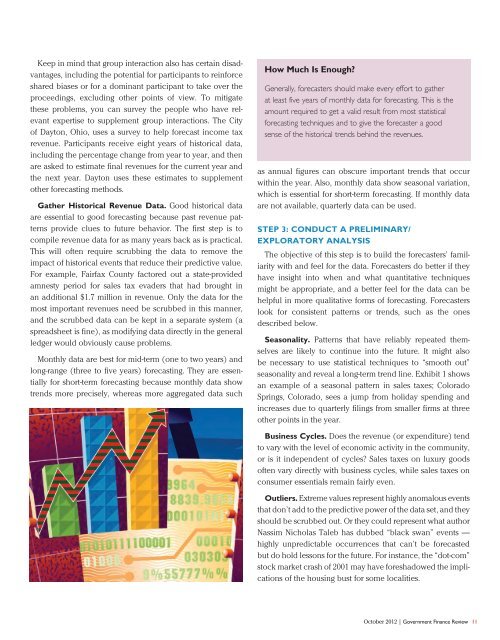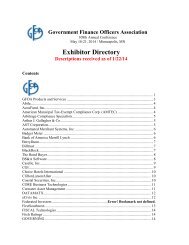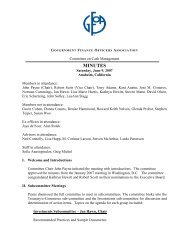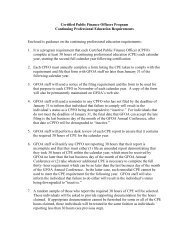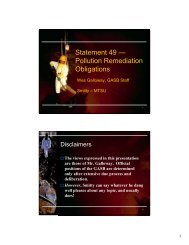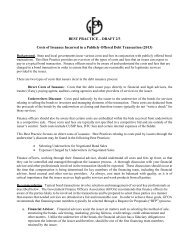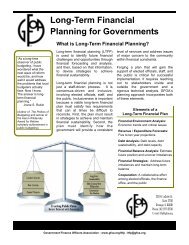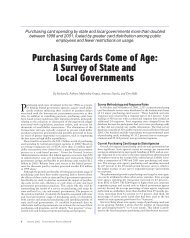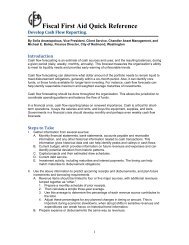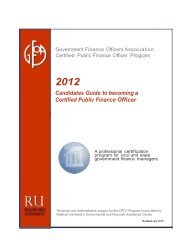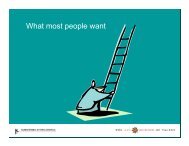Structuring the Revenue Forecasting Process - Government Finance ...
Structuring the Revenue Forecasting Process - Government Finance ...
Structuring the Revenue Forecasting Process - Government Finance ...
Create successful ePaper yourself
Turn your PDF publications into a flip-book with our unique Google optimized e-Paper software.
Keep in mind that group interaction also has certain disadvantages,<br />
including <strong>the</strong> potential for participants to reinforce<br />
shared biases or for a dominant participant to take over <strong>the</strong><br />
proceedings, excluding o<strong>the</strong>r points of view. To mitigate<br />
<strong>the</strong>se problems, you can survey <strong>the</strong> people who have relevant<br />
expertise to supplement group interactions. The City<br />
of Dayton, Ohio, uses a survey to help forecast income tax<br />
revenue. Participants receive eight years of historical data,<br />
including <strong>the</strong> percentage change from year to year, and <strong>the</strong>n<br />
are asked to estimate final revenues for <strong>the</strong> current year and<br />
<strong>the</strong> next year. Dayton uses <strong>the</strong>se estimates to supplement<br />
o<strong>the</strong>r forecasting methods.<br />
Ga<strong>the</strong>r Historical <strong>Revenue</strong> Data. Good historical data<br />
are essential to good forecasting because past revenue patterns<br />
provide clues to future behavior. The first step is to<br />
compile revenue data for as many years back as is practical.<br />
This will often require scrubbing <strong>the</strong> data to remove <strong>the</strong><br />
impact of historical events that reduce <strong>the</strong>ir predictive value.<br />
For example, Fairfax County factored out a state-provided<br />
amnesty period for sales tax evaders that had brought in<br />
an additional $1.7 million in revenue. Only <strong>the</strong> data for <strong>the</strong><br />
most important revenues need be scrubbed in this manner,<br />
and <strong>the</strong> scrubbed data can be kept in a separate system (a<br />
spreadsheet is fine), as modifying data directly in <strong>the</strong> general<br />
ledger would obviously cause problems.<br />
Monthly data are best for mid-term (one to two years) and<br />
long-range (three to five years) forecasting. They are essentially<br />
for short-term forecasting because monthly data show<br />
trends more precisely, whereas more aggregated data such<br />
How Much Is Enough?<br />
Generally, forecasters should make every effort to ga<strong>the</strong>r<br />
at least five years of monthly data for forecasting. This is <strong>the</strong><br />
amount required to get a valid result from most statistical<br />
forecasting techniques and to give <strong>the</strong> forecaster a good<br />
sense of <strong>the</strong> historical trends behind <strong>the</strong> revenues.<br />
as annual figures can obscure important trends that occur<br />
within <strong>the</strong> year. Also, monthly data show seasonal variation,<br />
which is essential for short-term forecasting. If monthly data<br />
are not available, quarterly data can be used.<br />
STEP 3: CONDUCT A PRELIMINARY/<br />
EXPLORATORY ANALYSIS<br />
The objective of this step is to build <strong>the</strong> forecasters’ familiarity<br />
with and feel for <strong>the</strong> data. Forecasters do better if <strong>the</strong>y<br />
have insight into when and what quantitative techniques<br />
might be appropriate, and a better feel for <strong>the</strong> data can be<br />
helpful in more qualitative forms of forecasting. Forecasters<br />
look for consistent patterns or trends, such as <strong>the</strong> ones<br />
described below.<br />
Seasonality. Patterns that have reliably repeated <strong>the</strong>mselves<br />
are likely to continue into <strong>the</strong> future. It might also<br />
be necessary to use statistical techniques to “smooth out”<br />
seasonality and reveal a long-term trend line. Exhibit 1 shows<br />
an example of a seasonal pattern in sales taxes; Colorado<br />
Springs, Colorado, sees a jump from holiday spending and<br />
increases due to quarterly filings from smaller firms at three<br />
o<strong>the</strong>r points in <strong>the</strong> year.<br />
Business Cycles. Does <strong>the</strong> revenue (or expenditure) tend<br />
to vary with <strong>the</strong> level of economic activity in <strong>the</strong> community,<br />
or is it independent of cycles? Sales taxes on luxury goods<br />
often vary directly with business cycles, while sales taxes on<br />
consumer essentials remain fairly even.<br />
Outliers. Extreme values represent highly anomalous events<br />
that don’t add to <strong>the</strong> predictive power of <strong>the</strong> data set, and <strong>the</strong>y<br />
should be scrubbed out. Or <strong>the</strong>y could represent what author<br />
Nassim Nicholas Taleb has dubbed “black swan” events —<br />
highly unpredictable occurrences that can’t be forecasted<br />
but do hold lessons for <strong>the</strong> future. For instance, <strong>the</strong> “dot-com”<br />
stock market crash of 2001 may have foreshadowed <strong>the</strong> implications<br />
of <strong>the</strong> housing bust for some localities.<br />
October 2012 | <strong>Government</strong> <strong>Finance</strong> Review 11


